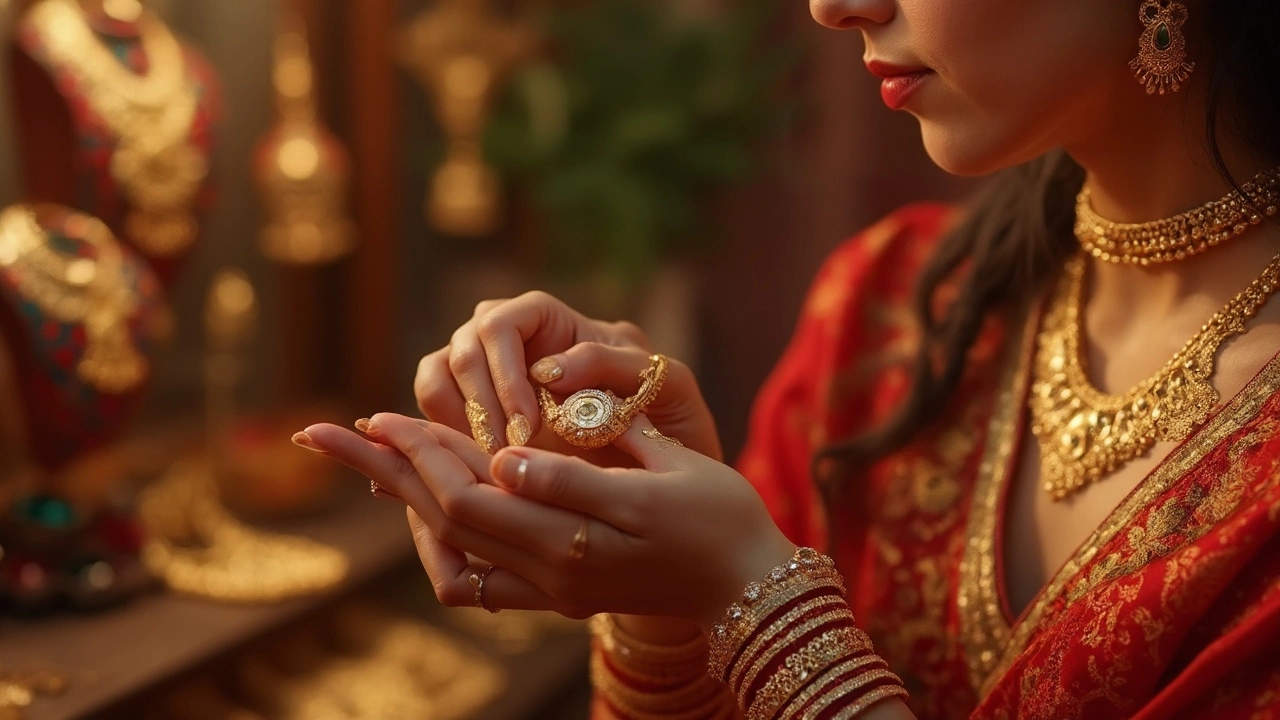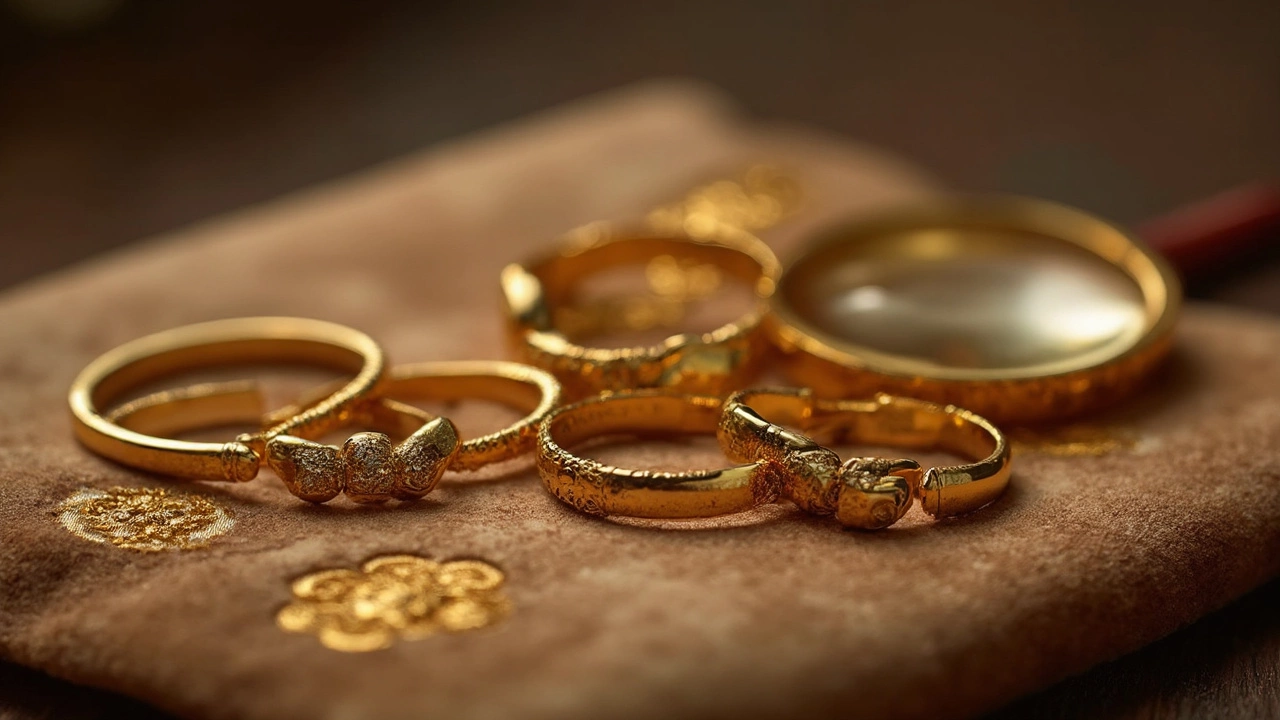
Ever noticed a tiny '750' stamped on the inside of a ring and wondered if it's some kind of secret code? Spoiler: it just means your ring is made with 18-karat gold. No, it’s not about luxury car models or anything technical—it simply points to the purity of the gold.
To break it down, the number 750 means 75% of the ring is pure gold. The rest (that other 25%) is usually a mix of other metals like copper, silver, or even a touch of zinc, making the gold tougher than pure gold, which is naturally pretty soft and bends easily. If you've heard someone ask if 750 is ‘real gold,’ the short answer is yes, but not pure 24k gold—it's a high-quality blend that stands up better to everyday life.
- What Does 750 Mean on Gold Rings?
- How 18k Gold Compares to Other Gold Purities
- Spotting Real 750 Gold vs. Fakes
- Why 750 Gold Is Popular in Jewellery Design
- Care Tips for Your 750 Gold Jewellery
What Does 750 Mean on Gold Rings?
When you spot a '750' stamped inside your ring, you’re holding 18-karat gold. It’s not just a random number—jewelers use it worldwide as a sign the gold is 75% pure. The rest (25%) is other metals added to boost the strength, because pure gold can scratch or bend way too easily. That ‘750’ isn’t just a stamp for looks; it’s a promise of quality and durability.
Here’s what those numbers actually mean in plain English:
- 750 on a ring: 75% gold, 25% mixed metals
- Originally from Europe, now common in the U.S., Asia, and more
- Other numbers like 585 (14k gold) or 417 (10k gold) mean lower gold content
To see how '750' compares to other gold markings, check out this quick breakdown:
| Stamp | Karat | Gold Content | Common Use |
|---|---|---|---|
| 750 | 18k | 75% | Fine rings, luxury jewelry |
| 585 | 14k | 58.5% | Mid-range rings |
| 417 | 10k | 41.7% | Everyday jewelry |
| 999 | 24k | 99.9% | Investment pieces, not durable for daily wear |
The law in places like the UK, Europe, and India actually requires this hallmarking, making it way easier to trust what you buy. Always check for this tiny number before spending big on gold—it's your solid proof that you’re getting the real deal. There are even handheld testers out there, but 750 is your first line of defense against fakes.
How 18k Gold Compares to Other Gold Purities
When you look at gold jewellery, you'll run into a bunch of numbers: 750, 585, 417, and the classic 999. These numbers tell you how much real gold is in your piece, which affects everything from color to price to durability.
Here's a quick cheat sheet with the main types:
| Marking | Karats | Gold Content | Common Name |
|---|---|---|---|
| 999 | 24k | 99.9% | Pure Gold |
| 750 | 18k | 75% | 18K Gold |
| 585 | 14k | 58.5% | 14K Gold |
| 417 | 10k | 41.7% | 10K Gold |
So, 18k (the one stamped 750 on a ring) has a pretty sweet spot. With 75% gold, you get a rich yellow look but also enough other metals to toughen it up. That makes it way more durable than 24k—which can scratch if you just look at it wrong—yet it still looks seriously gold.
Now, 14k (marked 585) is more popular in the U.S. It has a paler color since there's less gold inside, but it can take a beating—great if you're tough on your rings. If you see 10k (417), there's even less gold. It’s the cheapest to buy but doesn’t have the same warm tone or shine.
So why not just go for 24k? Well, pure gold is soft and bends easily. Most people want something that survives daily life, so 18k is a favorite for engagement and wedding rings in Europe and Asia. It brings the glam but still stands up over time.
Choosing between these all comes down to what matters more: true gold content, budget, or durability. If you want that classic look without non-stop worry about scratches, 18k is the solid middle ground. It checks most boxes for daily wear and long-lasting style.

Spotting Real 750 Gold vs. Fakes
The jewelry market is packed with pieces that look the part but aren’t always what they seem. Just because you see a '750' stamp inside a ring, it doesn’t guarantee you’ve got legit 18k gold on your finger. Here’s how you can tell authentic 750 gold from knockoffs and dodgy imitations.
First off, double-check the stamp. A lot of counterfeit rings use fake marks, so the 750 on a ring isn’t a sure sign on its own. Genuine rings show a clear, tidy '750' with precise, even font. Cheap fakes sometimes look sloppy, uneven, or the mark is barely visible.
Ever heard of nitric acid testing? Jewelers often use a simple chemical test. They scratch a tiny, hidden bit of the ring and put a drop of nitric acid on it. If nothing happens, the ring is gold as claimed. If it turns green or milky, you’re looking at gold-plated or a totally fake ring. Don’t try this at home unless you know what you're doing—acid’s no joke.
XRF (X-ray fluorescence) machines check the actual makeup of the metal and tell you the gold percentage without damaging your ring. Most jewelry shops or pawn shops have these now. Usually, you get a quick printout showing the breakdown—about 75% gold, the rest other metals.
- If the price feels way too good for 18k gold, be suspicious.
- Real 750 gold doesn’t tarnish easily. If your ring darkens noticeably, there’s probably something up.
- Weight matters: 18k gold is heavier than brass, copper, or steel—not crazy heavy, but it shouldn’t feel like plastic.
Here’s a quick look at what separates real 750 gold from fake or gold-plated rings:
| Test | Real 750 Gold | Fake/Gold-Plated |
|---|---|---|
| Stamp Quality | Clear, even, tidy | Blurry, uneven |
| Nitric Acid | No change | Green or milky reaction |
| Magnet Test | Not magnetic | Often magnetic |
| Wear Over Time | Keeps color | Color fades/peels |
| Weight | Feels solid, dense | Lighter, hollow feel |
If you want peace of mind, get your ring checked by a trusted jeweler—don’t just rely on the internet or a random stamp. Trust your gut: if it looks fake or feels wrong in your hand, question it. Saving yourself from a scam beats any price tag.
Why 750 Gold Is Popular in Jewellery Design
So why do jewelers reach for 750 gold again and again when coming up with new designs? Well, it mostly comes down to a mix of durability, bright color, and flexibility. Pure gold (24k) is so soft that it scratches and dents in no time, but blend in a quarter of other metals, and suddenly you’ve got something way tougher—without sacrificing that classy gold vibe.
750 on a ring is like the sweet spot between style and practicality. Designs made with 18k gold stand up better to the daily grind than 22k or 24k, so you can wear them all day without stressing about damage. At the same time, 18k’s deep yellow shine looks more luxurious than the paler glow of 14k or 10k gold.
There’s more to it: 18k gold also takes on cool finishes and texture really well. My wife, Maya, swears by her 18k wedding band because it hasn’t lost its polish after years of daily wear. Jewelers love that 750 gold casts clean shapes and holds onto stones better, so it opens the door to more creative designs than softer gold would allow.
Check out some real-world differences:
| Gold Type | Gold Purity | Color | Durability |
|---|---|---|---|
| 10k | 41.7% | Paler yellow | Very good |
| 14k | 58.5% | Warm yellow, but a bit muted | Great |
| 18k (750) | 75% | Rich yellow, bright | Good enough for daily wear |
| 22k | 91.6% | Deeper yellow | Soft, scratches easier |
| 24k | 99.9% | Deepest yellow | Softest, bends easily |
One more thing: 750 gold is perfect for sensitive skin, since the higher gold content means less chance of skin reacting to metals like nickel. Plus, this blend still has enough value to keep resale prices strong if you ever want to trade up your ring.
All in all, 750 gold ticks pretty much every box for everyday jewelry. You get shine, strength, and plenty of room for fun designs—no wonder it's a favorite in jewellery shops everywhere.

Care Tips for Your 750 Gold Jewellery
Even though 750 gold is tougher than pure gold, it still needs a little extra attention to keep it looking sharp. Dirt, lotions, and everyday grime can dull your ring’s shine faster than you'd expect. Simple habits make a big difference.
- Take off your rings before working with cleaning chemicals or doing household chores. Harsh stuff like bleach and ammonia can damage gold alloys or cause discoloration.
- If you swim a lot, keep your 750 gold jewellery out of chlorinated pools and hot tubs. Chlorine and gold are not friends—over time, chlorine can weaken the metal and cause cracks.
- Store gold rings and chains in a soft pouch or a lined jewellery box so they don’t scratch up against harder metals or gems.
- Wipe your jewellery with a soft, lint-free cloth after wearing it. This helps remove sweat and oils that can take away the shine.
A lot of people wonder about how often to clean their gold rings. It’s a good idea to give your jewellery a gentle wash once a month. Use warm water, mild dish soap, and a very soft toothbrush to scrub away build-up. Just make sure to rinse it well and dry it before you wear it again—gold hates to stay wet for long.
| Danger | Effect on Gold | Prevention |
|---|---|---|
| Chlorine (Pools/Hot Tubs) | Can pit and weaken gold alloys | Remove jewellery before swimming |
| Household Cleaners | May discolor or dull sheen | Wear gloves or remove rings |
| Hard Knocks/Scratching | Dents and scratches on surface | Store jewellery separately |
One tip I learned the hard way: avoid wearing 750 gold rings while doing sports or hitting the gym. A quick slip and sudden force can warp or even snap a delicate band. And if you want to keep your 750 on a ring mark readable, avoid polishing the inside of the ring often—over-polishing can wear down those small stampings after years.
If you’re ever unsure, dropping by your local jeweler once or twice a year for a professional clean and inspection never hurts. They can spot loose stones, restore that bling, and keep your favorite piece looking like new. And trust me, your future self will thank you.


